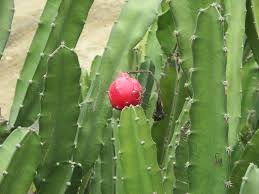Acanthocereus, also known as the Triangle Cactus or Fairy Castle Cactus (specifically Acanthocereus tetragonus), is a columnar cactus that is popular for its vertical growth and distinctive spires resembling castle towers. It has thin, triangular-shaped stems with small spines along the ribs. In nature, these cacti can grow quite large, but indoors they tend to stay more compact, making them an attractive option for both indoor and outdoor cultivation. Mature Acanthocereus cacti can produce large, white, night-blooming flowers, adding to their beauty.
Growing Acanthocereus Outdoors
Outdoors, Acanthocereus grows best in warm, arid climates with full sun. In regions where the temperature regularly stays above 50°F, it can be grown in the ground or in large containers. Choose a sunny spot in your garden where the cactus can receive at least 6 hours of sunlight per day. Well-drained soil is essential to prevent water from pooling at the base of the plant. If your soil is clay-heavy or doesn’t drain well, mix in sand or gravel to improve drainage.
Water the cactus deeply but infrequently, allowing the soil to dry out completely between waterings. During rainy seasons, ensure the plant doesn’t sit in waterlogged soil for too long, as this can lead to rot. Once established outdoors, Acanthocereus is very low-maintenance and drought-tolerant, requiring little additional care.
In colder regions, Acanthocereus is not frost-hardy, so it’s best to grow it in containers that can be moved indoors during the winter. Alternatively, you can protect outdoor plants with frost blankets if temperatures occasionally dip below freezing.
Whether grown indoors or outdoors, Acanthocereus brings a striking, architectural element to any space and is relatively easy to care for once you meet its light and watering needs.

Growing Acanthocereus Indoors
When growing Acanthocereus indoors, providing adequate light is the most important factor. This cactus thrives in bright, direct sunlight and needs at least 4 to 6 hours of light daily. A south or west-facing window is ideal, but if this isn’t available, you can use grow lights to supplement. Without enough light, the cactus can become elongated and lose its characteristic shape.
Water Acanthocereus sparingly. Like most cacti, it is drought-tolerant and prefers the soil to dry out completely between waterings. Water thoroughly when the soil is dry, but ensure the pot has good drainage to prevent root rot. The potting mix should be well-draining, so using a cactus-specific mix or amending regular potting soil with sand, perlite, or pumice is recommended. During the winter, when the cactus is in a dormant state, reduce watering even further.
Indoors, keep the temperature between 60°F and 85°F, and ensure the plant is placed in a room with good air circulation. Avoid placing it near drafty windows or vents in winter, as it’s sensitive to cold.
Related articles:



